| |
|
|
PADDLE-TAILED DARNER
Aeshna
palmata
|

photo (above &
just below) 22 Oct 2006
ESNERR © William Hull
all other photos below that are
© Don Roberson
|
| On Sunday, 22 Oct 2006, William Hull, a
visitor from Ohio, observed
5 or 6 Aeshna darners at "Cattail Swale" in Elkhorn Slough
National
Estuarine Research Reserve. He took a long series of photos, including
those above & below (© William Hull), and identified the
darner
as Paddle-tailed Darner on the basis of, among other things, the
paddle-shaped
appendage and the blue spots atop abdominal segment #10. This
identification
has been confirmed by Dennis Paulson. It represents the first record
for
Monterey County. A close-up of the male's appendage is below (photo
turned
90° for ease of viewing). Among the points mentioned by Paulson is
the shape of the 'paddle' — it gets wider beyond the halfway point.
Walker's
Darner
A. walkeri, which is of regular
occurrence in the MTY mountains,
has a paddle that reaches full width by the mid-way point (this is
illustrated,
but not mentioned, on Plate 19 of Manolis 2003). Paulson also pointed
to
the yellow color on the lateral thoracic stripes. The "T-spot" and the
dark line across the slightly yellowish face also fit A. palmata (see
Plate 19 of Manolis 2003). |

| William Hull, the discover of this new
range extension, is well-known
in the birding world for his Mangoverde
web site on Birds of the World, featuring a growing collection of
photos
and sound recordings that aims at some day having information on all
the birds of the world. He advises that he will soon be adding Odonata
to this web site.
This new MTY record is quite surprising. The
nearest known population
is in San Mateo County (Manolis 2003). Hull had 5-6 Aeshna (not
Blue-eyed Darners, in his opinion) between a dry pond and full
freshwater
pond at ESNERR. While these numbers might suggest a local breeding
population,
I wonder if they might be migrants or dispersals from farther north
that
either (a) moved together in a foraging/wandering flock or (b) found
the
same productive habitat while moving on their own in October. There
have
been many unidentified mosaic darners seen in flight along much of the
northern MTY coast this October, at places we don't think they breed
(i.e.,
no darners seem to frequent coastal spots in our foggy summers).
However,
both Dennis Paulson and Tim Manolis suspect that local breeding
populations
may be responsible for this record; A. palmata is not known to
be
migratory (Paulson) and the habitat at ESNERR is similar to
Paddle-tailed
breeding habitat in the coastal northwestern portion of California
(Manolis).
There is also an old record from San Diego County (Manolis 2003).
The October occurrence remains a bit of a
mystery — I was personally
very jazzed to hear about the first MTY record, and went to Hull's
exact
spot the next day (23 October). I did not find his Paddle-tailed Darner
— I found a different Paddle-tailed Darner (shots below; © Don
Roberson).
Compared to his photos, note the missing bits in the upper and low
left-side
wings, and note the fused blue spots on the 9th and 10th abdominal
segments:
|
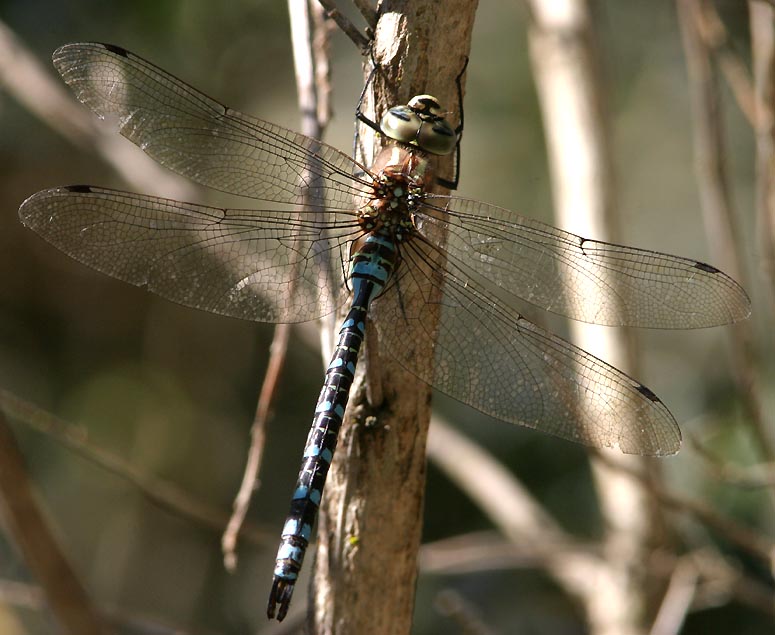
|
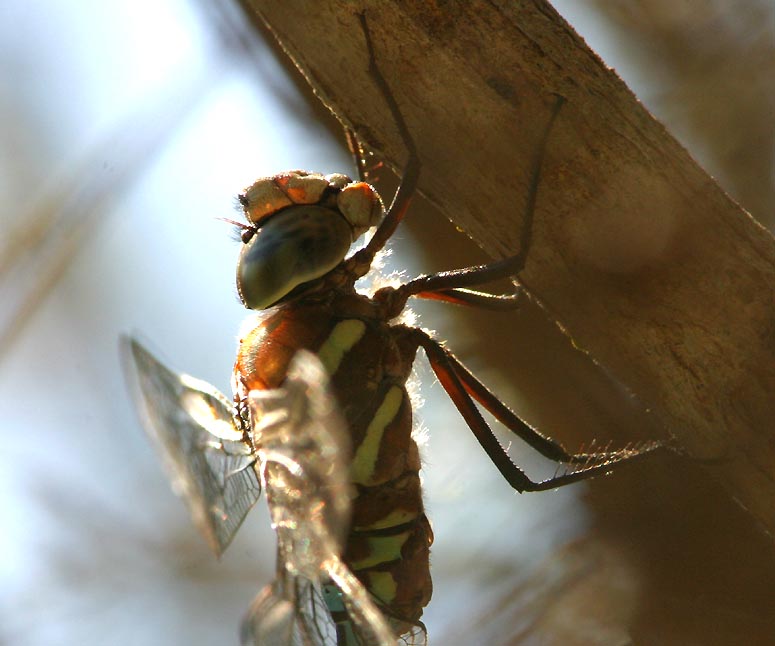
|
| See the yellow color to the lateral
thoracic stripes (above) the long
spine out the tip of the 'paddle' (right) that extends a bit beyond the
outer edge of the 'paddle' (again, the photo turned 90° for ease of
viewing). |
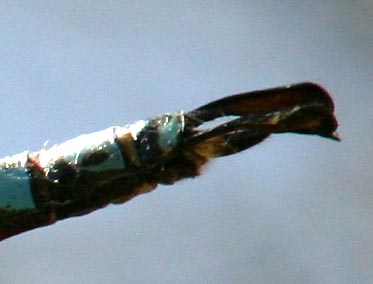 |
|
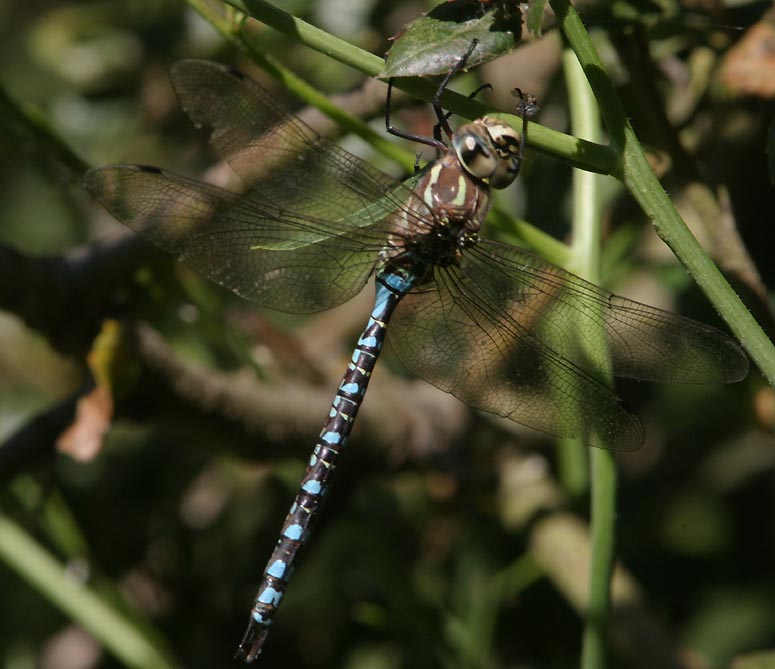
|
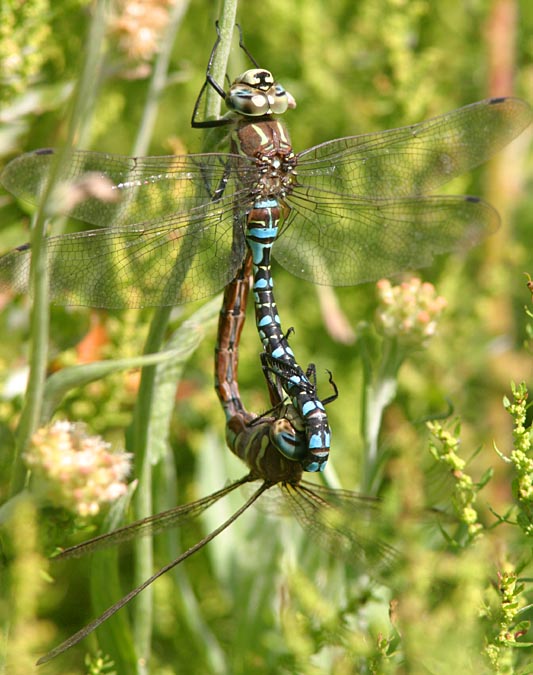 To
my suggestion that we could figure out their status in MTY "next
summer,"
Tim Manolis wrote: "Summer may not be the best time to look. October is
probably the time of year when they breed most actively. Indeed,
perhaps
the reason they have not been found before along the central coast is
that
there has been little prior odonate field work in late fall in this
area.
Who knows, they may well fly into November in your area." So with hopes
of sorting out the mystery of these darners — are they a new breeding
population
or vagrant wanderers — I tried again at mid-day on 29 Oct. To
my suggestion that we could figure out their status in MTY "next
summer,"
Tim Manolis wrote: "Summer may not be the best time to look. October is
probably the time of year when they breed most actively. Indeed,
perhaps
the reason they have not been found before along the central coast is
that
there has been little prior odonate field work in late fall in this
area.
Who knows, they may well fly into November in your area." So with hopes
of sorting out the mystery of these darners — are they a new breeding
population
or vagrant wanderers — I tried again at mid-day on 29 Oct.
I first spotted a male in flight over the same dry
pond as before, and
later a female — and then a tandem pair in flight! But the pair
disappeared
around a corner and I could not locate them. So I waited until the male
(or another male) started patrolling again along the edges of the dry
pond,
checking the thistle and weeds. He actually landed for a bit for views
and photos — it was yet a different male Paddle-tailed then any of the
two shown above.
Out of the corner of my eye I noticed a female in
flight over the dry
pond — and so did he! He was quick to grab her and wrestle her into the
pond-edge weeds, where I took this photo (right). They remained engaged
in this sexual position for at least the next 10 minutes.
|
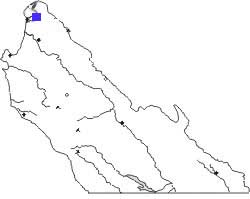 The
map (right) shows the only site so far for MTY: Elkhorn Slough National
Estuarine Research Reserve. The Reserve is open 9am-5pm Wed-Sun; also check
their web site. The habitat is tule-lined freshwater ponds adjacent
to willows, and not far from the tidal slough. The
map (right) shows the only site so far for MTY: Elkhorn Slough National
Estuarine Research Reserve. The Reserve is open 9am-5pm Wed-Sun; also check
their web site. The habitat is tule-lined freshwater ponds adjacent
to willows, and not far from the tidal slough.
The only known dates so far are 22-29 Oct;
elsewhere in California the
known flight dates are June to October.
One other bit of MTY history. For many
years, Hastings Natural History
Reservation in upper Carmel Valley maintained a collection of Odonata;
that collection is now at the Oakland Museum. An Aeshna in that
collection from HNHR in July 1943 was labeled A. palmata. Tim
Manolis
reviewed that specimen this summer (Aug 2006) and re-identified the
specimen
as Walker's Darner A. walkeri. So it got taken off the
MTY
list in August 2006, and then Bill Hull put in right back on just two
months
later. . . .
For reference, I add (below) a flight shot
of Paddle-tailed Darner taken
in August at over 7000' elev. in Alpine Co., California.
|
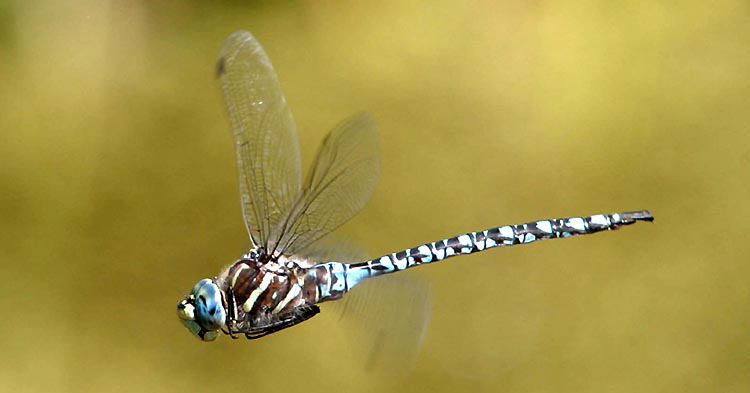
|
|
Literature cited:
- Manolis, T. 2003. Dragonflies and Damselflies of
California. Univ. of
Calif.
Press, Berkeley.
Web resources:
Major identification web sites with much information on California
odes include:
For sites with excellent photos to compare for identification or to
simply
enjoy, see:
Many of these sites have links to other useful pages. Kathy Biggs's
site
is particularly useful in her selection of links. |
|
Photos © Don Roberson 2007, except
those attributed to © William Hull, used with permission; all
rights reserved
TOP
|
|
|
|
|
|
|
|
|



 The
map (right) shows the only site so far for MTY: Elkhorn Slough National
Estuarine Research Reserve. The Reserve is open 9am-5pm Wed-Sun; also
The
map (right) shows the only site so far for MTY: Elkhorn Slough National
Estuarine Research Reserve. The Reserve is open 9am-5pm Wed-Sun; also